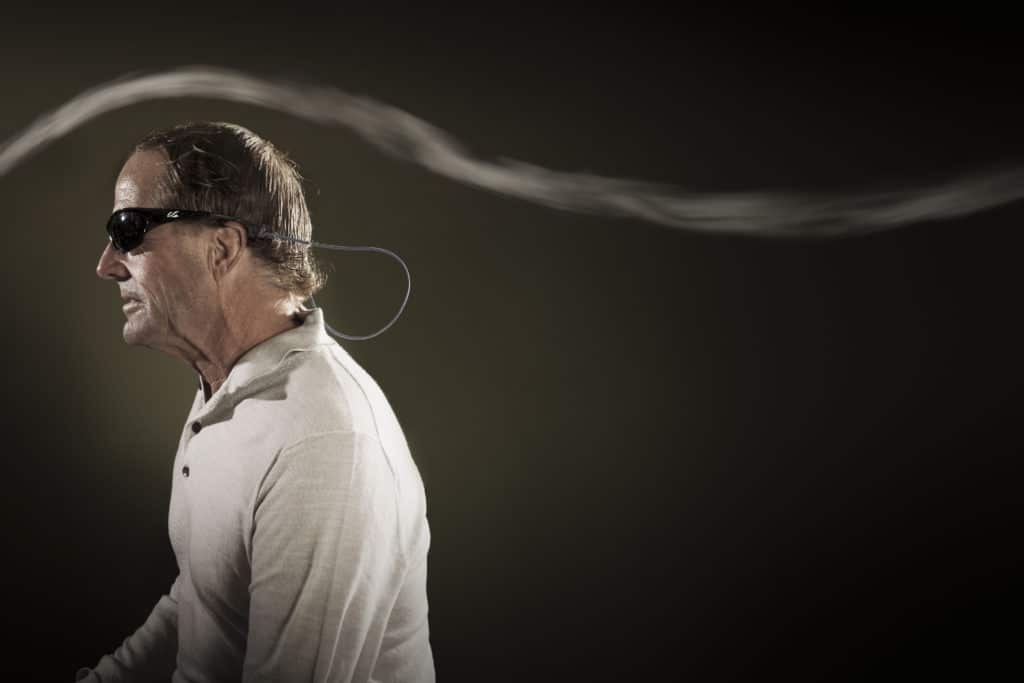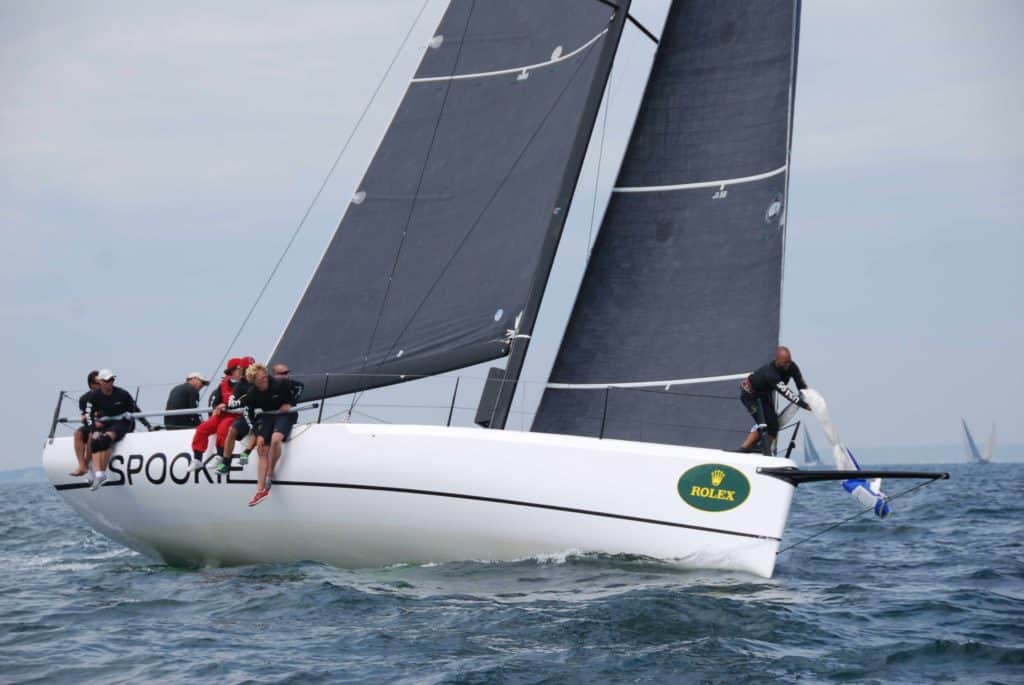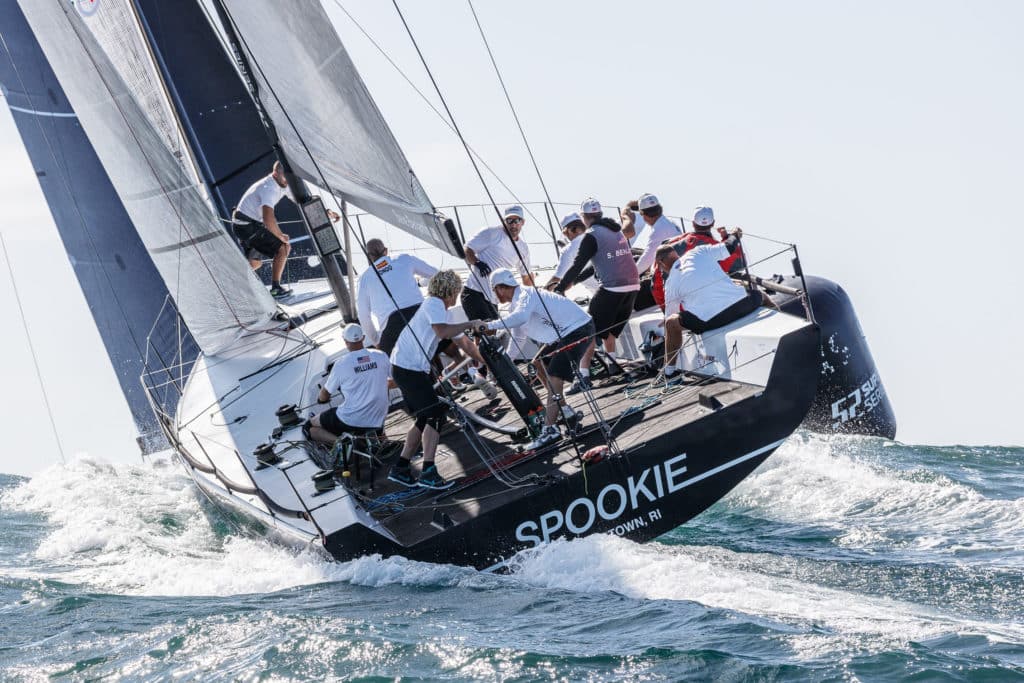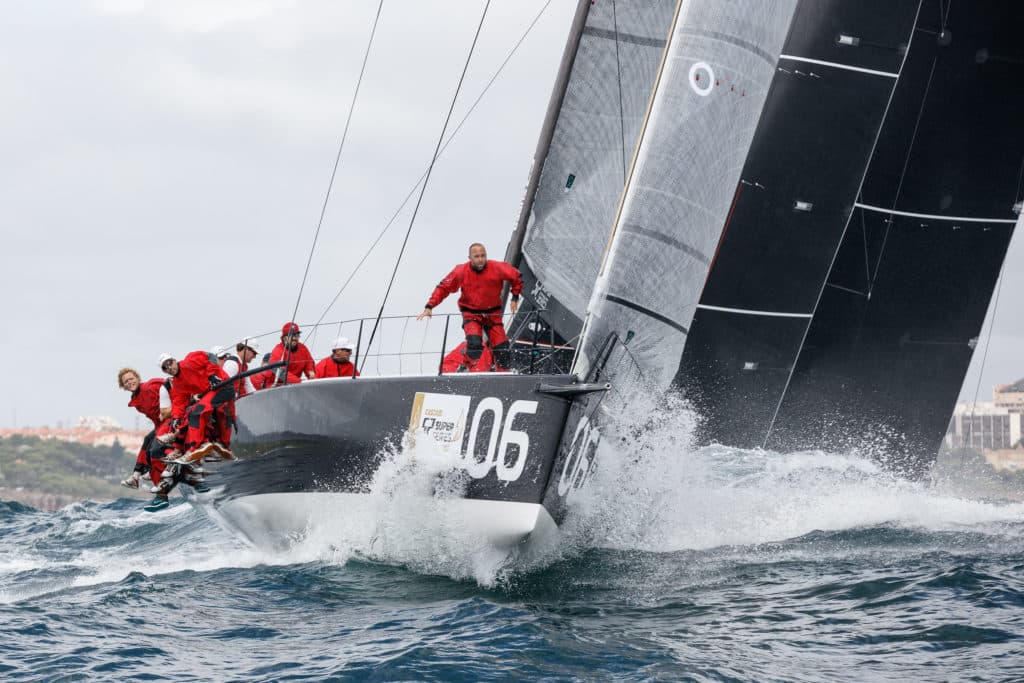The summer of 1976 was the turning point in Steve Benjamin’s sailing career. He’d just come off a disastrous first attempt at the Olympic Trials in the 470, finishing in double-digits. On the way home from that event he fell asleep at the wheel, crashing his car into a ditch and damaging the boat. With the help of a local farmer, he got his car and 470 back onto the road, making it to his parent’s home in Long Island, N.Y., later that day.
“There I was, licking my wounds with the whole summer in front of me-I had several months before I had to get back to Yale,” he tells me when we meet outside his Jamestown, R.I. home, a white bayside structure with multiple garage bays that, with beds for 20, can easily accommodate his big-boat crew and then some. “It was a really low time.”
Then came a fortuitous phone call from one Tucker Edmundson, whom Benjamin had known from the Fireball dinghy circuit. Edmundson, who mostly crewed, had a really fast Fireball and needed a helmsman for the class’s world championship in Halifax later that summer.
“You interested?” asked Edmundson.
Benjamin’s response was immediate. “Hell yeah, I’m be interested.’”
The two trained hard that summer and arrived in Halifax for the pre-worlds. “We were going well, but not well enough to win a world championship,” recalls Benjamin. At one point during the final race of the pre-worlds, Edmundson asked his skipper if he’d tried pulling on the vang. In frustration, Benjamin sarcastically replied, “Yeah, I pulled on the vang.”
Then Edmundson, 6’4” and 185 pounds, suggested he try himself.
“He comes in off the trapeze, bends his knees, grabs the thing with both hands, then extends out, and pulls on it,” says Benjamin. “The boom bends like a banana, and the boat just started planing upwind. We passed five boats on the final beat.” The pair went on to win every race of the Fireball World Championship, except for one in which they were over the starting line early.
“The Fireball class was a big deal,” says Edmundson. “Here were these two young punks who just humiliated the royalty of Europe. Everyone was there-New Zealand, Australia, Brazil, South Africa.”
Not only was Benjamin’s first real foray into international sailing competition a stunning victory, but Time/Life photographer George Silk was there to document it, and photos of the pair team appeared as a feature in Sports Illustrated magazine. “We became famous overnight,” said Edmundson. They went on to win a world championship a second time in the Fireball and in another high-performance dinghy, the International 505. Within the next decade, Benjamin went on to win silver medals at the Olympic and Pan Am Games, both in 470s, plus a host of other trophies in offshore race boats as well.
Today, at age 58, Benjamin is only a bit heavier than the svelte 130 pounds he maintained while campaigning the 470. His long, dirty blonde hair is slightly shorter and thinner, and no longer held in place with the trademark bandana he sported in his younger days. “On the outside, he appears a bit like a child of the 1960s, but on the inside, he’s a focused, elite athlete,” says Peter Isler, a professional sailor and teammate on the Yale Sailing Team.
Spend time with Benjamin on the racecourse, the tennis court, or in any other competitive environment and it’s easy to get a sense of the competitive intensity smoldering beneath the surface. With everything, it’s all business-and methodical. Take, for example, his vast collection of spiral-bound notebooks, records of his racing, documenting every nuance of every race. How many notebooks are there? “Reams and reams of them, on shelves, in boxes,” he says.
He hands me two notebooks from the 1983 470 Worlds in Weymouth, England, and I flip one open to a page somewhere in the middle. Taped onto the left-hand page is a weather map for one day of the event. Surrounding it and carrying over to the next page are handwritten notes about top-batten tension, rig settings, polars, questions that need to be answered, parts that need to be replaced, and even a chart about what personal sailing gear he needs to order. “This was the kind of approach I used then, and I still use it today,” he says. “Every day it’s recording diagrams of what worked and what didn’t.”
Stan Honey, a professional navigator and technical entrepreneur who was another of Benjamin’s college roommates and a teammate at Yale says, “He did have an amazing focus on boat preparation and was extremely exacting about it. He was a fanatic.”
At Yale, Benjamin was one of a cast of talented sailors that won the 1975 Intercollegiate Dinghy Championship title, and in 1978 he was named College Sailor of the Year. If collegiate sailing served as the appetizer for Benjamin’s boatspeed appetite, the main course came by way of the open-class designs of the era; the Fireball, 505, and 470, all high-performance and highly tunable boats with three-stay rigs. “He was on the forefront of totally cranking the heck out of the three-stay rig,” says Isler. “He was twice as cranked up as anybody else.”
“We built the boat to take it,” says Benjamin. We had custom fiberglass layups, hired Gary Carlin, a fiberglass expert, as a consultant, and he provided the formulation for vinylesters. We were one of the early boats to use it, which in those days was still legal in the 470.” “Never would we see Benj in an open class sailing with the same gear as everyone else,” says Isler.
This always gave him the competitive edge, but there was also an air of confidence influenced by Neal Fowler, who crewed for Benjamin in the 1980 Olympic 470 Trials. Fowler had an attitude that resonated with Benjamin: “Going into the regatta he [Fowler] said that there was absolutely no reason why we weren’t going to win. His attitude was ‘everything we were doing is correct, and there’s nobody who should be able to beat us, and there’s nobody who will beat us.’ I liked that.”
They went on to win the Trials before President Jimmy Carter ordered a boycott of the Olympic competition. Four years later, this time with Chris Steinfeld as crew, Benjamin campaigned again, won the Trials, and came home with a silver medal.
“If Benjamin decides something is worth doing, he’s basically an unstoppable force,” says Honey.
It was his parents who instilled the drive in him from a very young age, says Benjamin. “My mom and dad gave me the resources and the training and the opportunities to perform, not just in sailing, but in everything.”
As a junior sailor at Long Island’s Seawanhaka YC, he crewed on Thistles with Jim Miller, owner of the Oyster Bay Boat Shop, and landed podium finishes in that class’s national and midwinter championships. As a junior, he also met Skip Whyte, was Seawanhaka’s head instructor. “It was a typical Long Island Sound summer, which meant that a lot of times there was no wind,” says Whyte. “So there was a lot of time to talk about boat tuning and so on. Benj would be way engaged in this stuff.”
After Yale, Benjamin started his own marine hardware business, International Sailing Products, specializing in racing equipment. In 1980, he ran Ullman Sails East and switched to Banks Sails in 1988, where he established 26 lofts around the country. “We were on the early wave of sails from China,” he says. “The pricing was good, and we were really competitive, but we were also feeling that 3DL sails were superior.”
That realization led to a change over to North Sails in 2000, where, instead of being an owner, he was a salesman. “It was a really positive change in my life-a lot less stress, more sailing, and a higher level of sailing.” He was North’s top salesman for three years. Now, he’s a consultant for the sailmaker and works with a select group of 20 or so clients.
Up until his recent transition to the world of TP 52 sailing with Spookie, much of his racing focused on the Carkeek 40 sharing the same name. The 9,000-pound, all-carbon keelboat was essentially an extension of the 470 and 505, which he purchased in 2012 with and his wife, Heidi. As with his efforts in smaller boats, Spookie, too, was born out of a level of intensity, this time from an administrative level. He chairs the New York YC Rating and Measurement Rules Committee, pushing forth the new High Performance Rule, as well as the implementation of a universal measurement system that would allow boats to be measured the same way anywhere in the world.
“In 2011 and 2012, our committee was looking at the state of the rating rules and saying there really is no rule for just planing, fast boats,” says Benjamin. “Why don’t we see if there is a solution for that? Is there a simple, transparent system using like an excel spreadsheet and today’s technology, and the universal measurement system? We wanted to take the measurements from the measurement system, plug them into the HPR calculator and come up with a rating. So, we got a budget together, funded it, wrote it, and it’s working. In the process of all that, we went to the designers and administrators and all, and were asking, what would an HPR boat actually look like?” An HPR design looks like Spookie.
In the summer of 2014, while observing a practice session, it was obvious his intensity hasn’t diminished with age. “Two days of practice before an event is typical,” says Matt Reynolds, one of several people who oversee the Spookie program. In 2014, the boat sailed roughly 100 days between practices and races.
It’s always been that way, says Edmundson. “We’d show up at the regatta, and the other guys would be, like, ‘Hey, there’s a keg at the yacht club.’ They’d be standing around with their beer in their hands and talking, and maybe it’s cold and rainy and blowing like hell, but we’re pushing off the dock to go sailing.”
It’s just after noon, and Spookie’s crew has been busy preparing the boat all morning. The team is made up of mostly 20-somethings, Benji protogés. “I like the dynamics of the team . . . and they do hike harder,” says Benjamin with a grin.
Chuck Swanson, the navigator, is calibrating an instrument that will record rudder angle, and Chris Williams, a designer with North Sails and jib trimmer aboard Spookie is fitting shims beneath the mast to get the rig tension he wants. Benjamin arrives dockside with little fanfare. Reynolds goes over the plan for the afternoon. We finish up sandwiches, and then all the non-essential gear is offloaded to a hard-bottomed inflatable tender that will shadow us throughout the afternoon. As on the 470 or 505, there’s a strong correlation between weight and speed. “Spookie is very weight sensitive,” says Benjamin. “One of the fun things about the boat is just how rewarding it is to positioning of the crew, how we trim the boat. Basically, in light air, we’re sailing with four to six degrees of heel just to have the minimum wetted surface. In heavy air, we need 23 degrees of heel upwind to get the dynamic stability of the leeward side.” It’s a studied science, of course.
Once sails are hoisted, it’s straight to race mode. The navigator gives us time on port and starboard tacks, and, as expected, each crew is focused on their job. Benjamin sits at the helm, positioned in the middle of all of the activity. He’s quiet, except for an occasional “copy that” when the navigator gives him information that will affect how he steers the boat.
We come into a practice leeward mark rounding at 9 knots, and at one length away from the mark the grinders bring in the takedown line, sucking the big spinnaker into the forward hatch in seconds. We round the mark in perfect form. Later, a hoist gets fouled, but Benjamin doesn’t say a word. After the crew quickly gets it squared away he says to me with a smile, “That’s why we’re out here practicing.”
Two days later, Spookie would decisively win its class at the New York Yacht Club Race Week.
“I don’t see it [the intensity] just in sailing,” says Benjamin. “I see it as an attitude and an inner philosophy of trying to do well at anything I decide to take on, whether it’s sailing or investing, or real estate. Whatever it is, I want to excel at it. To me, that’s the challenge. Sailing gives me easy metrics. I get a result, and I can calibrate how we’re doing.”
By all standards Benjamin is continuing to push himself off the water as well, active on several committees. He was chair of the Yale Sailing Association for 20 years and brought the program from its club sport to varsity status. He serves on the boards of the Offshore Racing Association and US Sailing, the Hudson River Community Sailing and Storm Trysail Club. He chairs the Sailing Yacht Research Foundation and a U.S. representative to the ORC.
He’s also doing his part to get young sailors involved in big-boat racing, using his other boat, a custom Tripp 41 and project boat called High Noon, providing young sailors, including the Noroton YC (Conn.) junior offshore team with opportunities to get on the water and compete. If there’s one thing missing from his résumé, though, it’s his absence from such high-profile events as the Volvo Ocean Race or the America’s Cup. Even that is by design. “One of the great things about the sailing I’ve been doing and my experiences is that I’ve been able to share it with Heidi,” he says. Winner of the women’s doublehanded championship, she also ran her own 470 campaign so the couple clearly speak the language of speed. They’ve been married more than 22 years.
“She asked me not to do a Volvo or America’s Cup,” says Benjamin. “She said, ‘I’ll support you in everything you do, but I really don’t want you going off for weeks, months on end.’ I said, ‘Fine, because I really don’t have any ambition to want to do that stuff.’ On Spookie, she’s tactician, and there’s plenty of sailing to be done. I really don’t miss it.”
He’s also been lured to the Etchells class in the past year, and there, too, the development never stops. One of the garage bays at his Jamestown home is piled deep with sails-up to 53 at the time of my visit-all numbered, all logged into a notebook with comments, ready for the Benjamin approach.
Today, he focuses on his TP 52 that shares the Spookie namesake.



©2015 Martinez Studio










